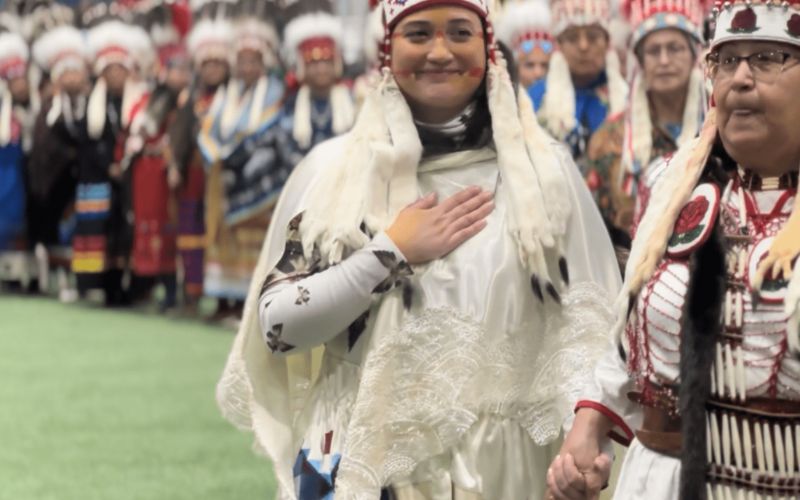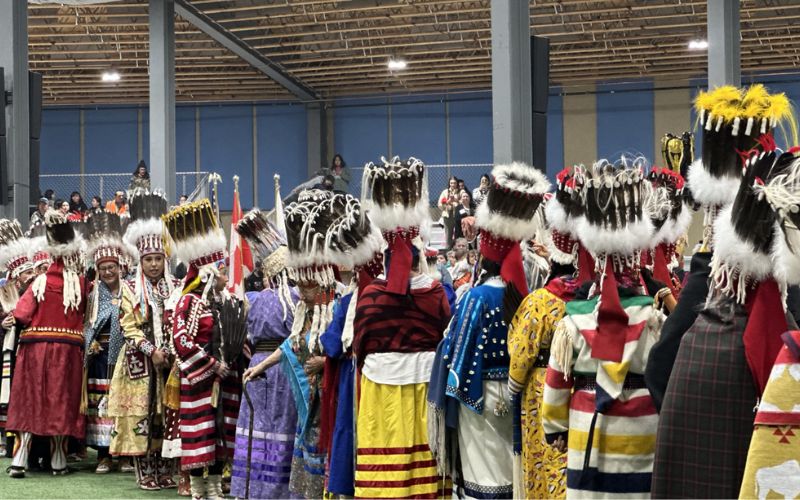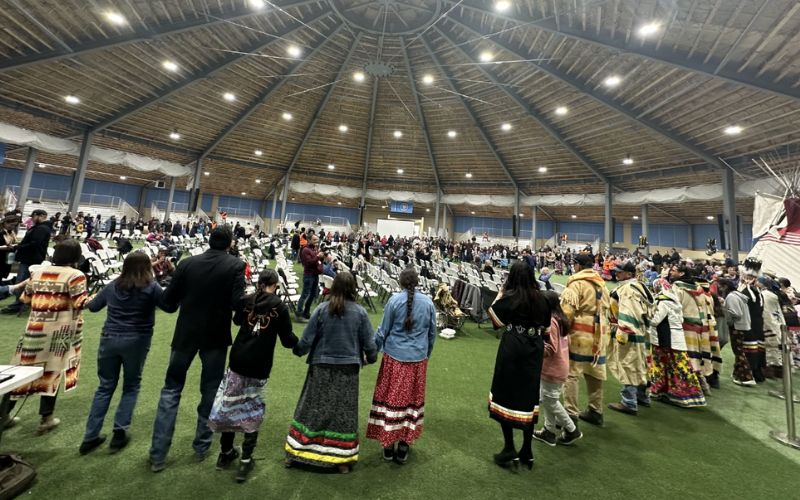
- Details
- By JoVonne Wagner, Montana Free Press
More than 350 empty white chairs filled the recently built arbor at the center of the campgrounds in Browning, the headquarters of the Blackfeet Nation.
This article was originally published in the Montana Free Press.
Later Tuesday, those seats, along with bleachers that surrounded the perimeter of the building, were filled with families, friends, children and tribal leaders from the Blackfoot Confederacy, all in attendance to celebrate Lily Gladstone.
The ceremony was meant to welcome home Gladstone, who was born and raised on the reservation before moving to Seattle, and honor her with a stand-up headdress, a tradition that recognizes a member of the community who has demonstrated leadership, respect and responsibility.
“It’s people like Lily who are paving the way for a better tomorrow, and as you can see hard work, it does take you a long way,” Blackfeet Tribal Business Council member Pat Armstrong said during the celebration.
Gladstone, Blackfeet and Nez Perce, an actress who studied at the University of Montana, last year starred in Martin Scorsese’s film, “Killers of the Flower Moon,” which was based on the nonfiction book written by David Grann about murders of the Osage people during the 1920s.
 Members of the Blackfoot Confederacy Women’s Stand-up Headdress Society embrace and welcome their newest member, Lily Gladstone at the event in Browning, Montana, on Tuesday, March 26, 2024. Credit: JoVonne Wagner / MTFP
Members of the Blackfoot Confederacy Women’s Stand-up Headdress Society embrace and welcome their newest member, Lily Gladstone at the event in Browning, Montana, on Tuesday, March 26, 2024. Credit: JoVonne Wagner / MTFP
Her performance garnered Gladstone “Best Actress” in the Golden Globe and Screen Actors Guild awards, as well as an Oscar nomination. When Gladstone won her Golden Globe award, a first for a Native actor, she delivered part of her acceptance speech in Blackfeet.
The ceremony this week included presentations from tribal leaders and Gladstone, a round dance, a feed, and the opportunity for community members to personally meet and congratulate Gladstone.
For many, it was a chance to embrace what is possible.
“It’s true, if you work hard you can do it,” Gladstone told the crowd that included scores of area children. “I feel so lucky and blessed that I’m Blackfeet, that I get to be here. I was brought up and I continue to be brought up by all of you. I try to do my best to bring everyone up with me because that’s what we do, it makes us who we are.”
“It’s really a special thing to be who we are, to be where we’re from, and I know sometimes it could be a really hard thing, too, but all good things are hard things and are shared and we take care of each other. I would not be here, I wouldn’t have been able to do anything good with my life if I didn’t come from good people.”
Gladstone’s ceremony brought together the four bands that make up the Blackfoot Confederacy: the Siksika, Kainai and Northern Peigan-Piikani, who all come from Canada, and the Southern Amskapi Piikuni from Montana. Several tribal leaders praised Gladstone and noted what her accomplishments had meant to their communities.
“It showcases Blackfeet to the world,” Blackfeet Business Tribal Council member Everett Armstrong told Montana Free Press. “The significance of being on a world stage, our language being on a world stage. The presence of a Blackfeet person on a world stage. It just means everything to me.”
Theda New Breast is a part of the Blackfoot Confederacy Women’s Stand-up Headdress Society that gathered for the celebration. The society members are women from across the Blackfoot Confederacy who have earned the right to wear the headdress. Multiple rows of women who wore their headdresses sat on the side of the main stage during the event.
“We have over 200 women’s stand-up headdress society [members], and we’re thinking at least a third of them are coming today,” New Breast said. “They’re the ones from Alberta that don’t come down to America, but they want to honor Lily.”
Another Blackfeet Council member, Robert DesRosier, spoke during the event and welcomed Gladstone home.
“One of the things she said last night that really struck me right here,” DesRosier said, motioning to his heart, “was, ‘It’s like I made it full circle coming back’ and that’s what makes us whole when our brothers and sisters come down, and we’re full circle and we’re relatives and we all love each other.”
 Attendees of the Lily Gladstone celebration form a circle for a round dance on Tuesday, March 26, 2024. Credit: JoVonne Wagner / MTFP
Attendees of the Lily Gladstone celebration form a circle for a round dance on Tuesday, March 26, 2024. Credit: JoVonne Wagner / MTFP
The Browning community’s youth also shared their support for Gladstone’s homecoming. The Stamiksiitsiikin Bullshoe Elementary’s kindergarten and first-grade students and De La Salle Blackfeet School students each gave a prayer in the Blackfeet language.
“It’s just a big inspiration, especially to our youth here in Browning,” said Mariah Posey with the Pikuni Youth Council. Gladstone’s accomplishments “showcase that anything is possible if you put your mind to it.”
Carol Tatsey-Murray, who in May, along with Gladstone, will receive an honorary doctorate from the University of Montana, said that the celebration was impactful not just for the younger generation but for the tribal elders as well.
“I’m here to honor the achievement of a Blackfeet lady, and I’m very, very impressed that the whole world acknowledged her and so I just wanted to come and be a part of it,” Tatsey-Murray said. “It was amazing. Although there were a lot of youth, I think it was just a kind of a dream for the older ones to just dream that it could happen. It could happen, and it’s happening. That’s what’s amazing.”
Help us defend tribal sovereignty.
At Native News Online, our mission is rooted in telling the stories that strengthen sovereignty and uplift Indigenous voices — not just at year’s end, but every single day.
Because of your generosity last year, we were able to keep our reporters on the ground in tribal communities, at national gatherings and in the halls of Congress — covering the issues that matter most to Indian Country: sovereignty, culture, education, health and economic opportunity.
That support sustained us through a tough year in 2025. Now, as we look to the year ahead, we need your help right now to ensure warrior journalism remains strong — reporting that defends tribal sovereignty, amplifies Native truth, and holds power accountable.
 The stakes couldn't be higher. Your support keeps Native voices heard, Native stories told and Native sovereignty defended.
The stakes couldn't be higher. Your support keeps Native voices heard, Native stories told and Native sovereignty defended.
Stand with Warrior Journalism today.
Levi Rickert (Potawatomi), Editor & Publisher

